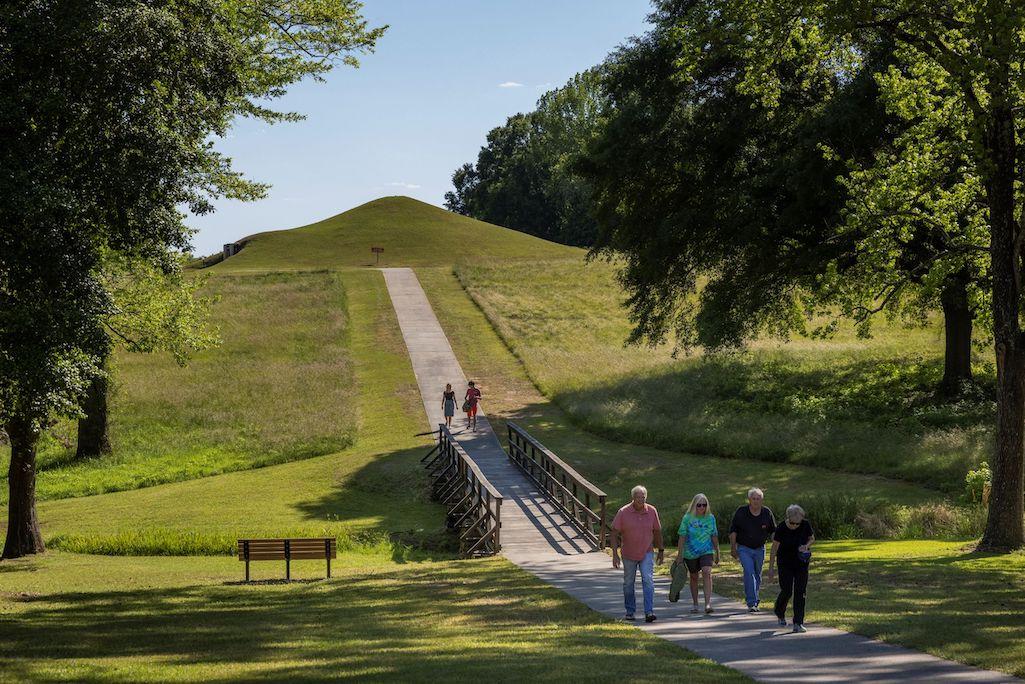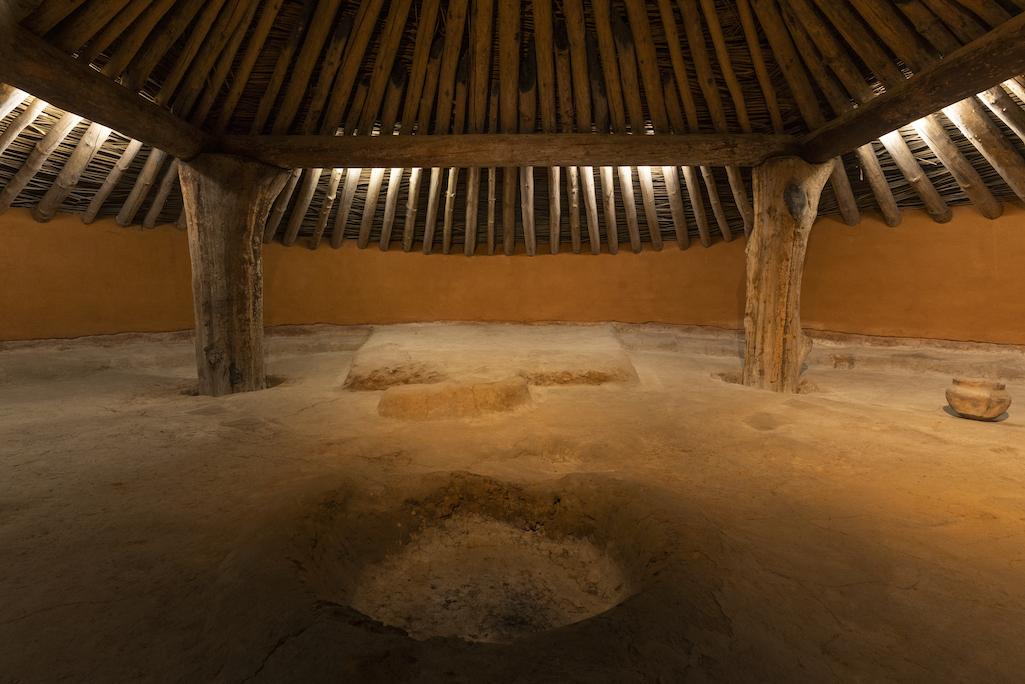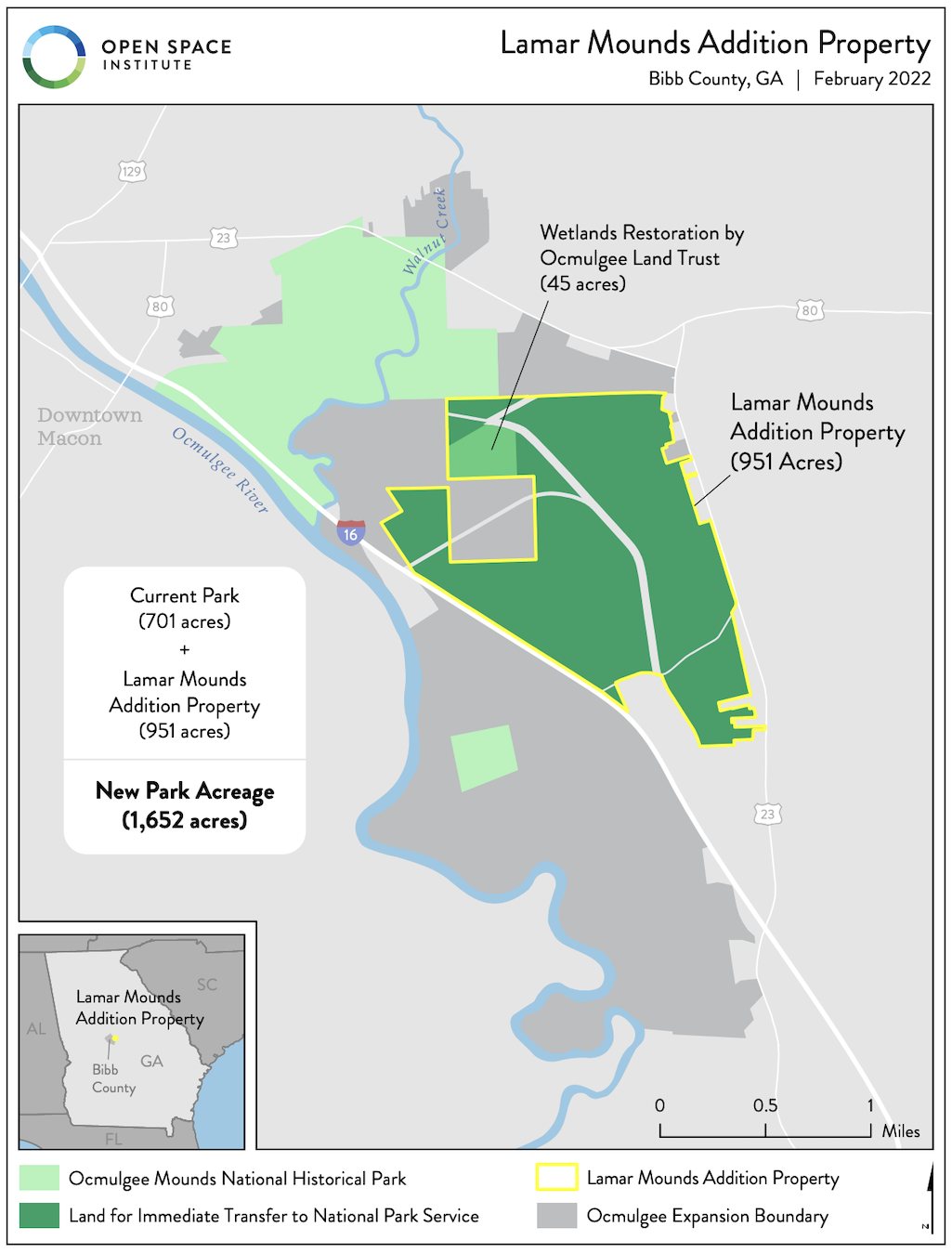
More than 900 acres have been added to Ocmulgee National Historical Park in Georgia/Open Space Institute
Editor's note: This updates with additional comment from the Muscogee (Creek) Nation.
A small slice of the past that tells part of the story of the Muscogee Nation in a unique series of earthen mounds has more than doubled in size with the addition of more than 900 acres to Ocmulgee National Historical Park in Georgia.
The park is reminder of the many cultures that have inhabited the area in and around present-day Macon for 17,000 years. They were drawn to the area near the Ocmulgee River with its fertile hunting and fishing habitat. According to the National Park Service, "Paleo-Indians first came to Middle Georgia during the Ice Age. The first people to this area were nomadic hunters and gathers who occupied this area for thousands of years. Around 900 C.E a new culture arrived," the Park Service says, "where they constructed these unique mounds for the elite members of their society."
The mounds include the Great Temple and other ceremonial mounds, a burial mound, and defensive trenches. The acquisition announced Wednesday provides additional protection for what the Park Service described as some of the most significant prehistoric Indigenous mounds in North America.
The newly protected 951-acre property is located adjacent to the park and inside the city limits of Macon. The property was under threat of incompatible industrial development before the Open Space Institute facilitated a deal to purchase the land in 2021. The project is the result of a major expansion of the park in 2019, quadrupling the authorized boundary from 701 acres to more than 3,000 acres.
Financial details of the transaction were not immediately released. However, the Biden administration had included part of the acquisition in its Fiscal 2022 Land and Water Conservation Fund expenditures.
The park is located on the east bank of the Ocmulgee River, and the city developed around the site after the United States built Fort Benjamin Hawkins nearby in 1806 to support trading with Native Americans. The Dingell Act passed in 2019 expanded the boundary by 2,100 acres to encompass the area that was defined in the park's original 1934 bill.

The Earth Lodge, dated to 1015 AD, was built by the Mississippian culture and later restored from archaeological evidence and is part of Ocmulgee National Historical Park/Open Space Institute, Mac Stone
With the protection of the property announced Wednesday, 906 acres were to be immediately transferred to the National Park Service as an addition to the park. The remaining 45 acres were to be transferred to the Ocmulgee Land Trust, which would hold the land while wetlands restoration occurs and then donate it to the NPS.
The additional acres are located to the east of the previous park boundary and situated within the “Ocmulgee Old Fields,” also known as the Macon Reserve, a three-by-five mile site revered as a sacred place to Muskogean people, the Park Service said in a release announcing the acquisition. The Ocmulgee Old Fields-Macon Reserve is comprised of lands specifically retained by the Muscogee (Creek) Nation from 1805 until the 1826 Treaty of Washington, which in addition to other treaties culminated in removing the Muskogean people from their ancestral home to present-day Oklahoma.
“This additional property includes some of our most important unprotected ancestral lands. The Muscogee (Creek) Nation have a long-standing history of preserving the Ocmulgee Old Fields-Macon Reserve. We have never forgotten where we came from and the lands around the Ocmulgee River will always and forever be our ancestral homeland, a place we consider sacred and a place with rich cultural history,” said David Hill, principal chief of the Muscogee (Creek) Nation.
Jason Salsman, a spokesman for the Creek Nation, said during a phone call that the acquisition is important in part because it provides greater protection for ancestral homelands.
"We want to make sure that ancestral ancestral lands are environmentally sound, that they are free from any excavation that we've experienced before," said Salsman. "And we want to just make sure that we have a presence there, that everything is done correctly, with correct consultation with us, our historical cultural preservation department, our environmental services department. ... It's all a part of our beginning and where we came from originally. And so for us, the significant side, we can't further our story, we can't continue our story, without knowing exactly where we came from. So that all goes hand-in-hand with how significant that is."
The spokesman could not say whether the land contains archaeological resources or whether there might be excavations there in the future. But he said it's important that the Muscogee Nation be consulted every step of the way, and that he expects it to be a partner with the Park Service as that agency works on developing management and interpretive plans for the site.

Park Service Director Chuck Sams said that it is his agency's "solemn duty and honor to protect our nation’s most significant lands. It’s even more critical that we work collaboratively with Tribal nations to ensure proper conservation and access. The National Park Service will continue to work with willing sellers to preserve the culturally significant land associated with the Ocmulgee Old Fields.”
The park is the site of the largest archaeological excavation in American history, producing more than two million artifacts, in the 1930s. The park’s striking mounds were created by highly skilled Indigenous engineers and today constitute one of America’s most important cultural landscapes. Seven of the mounds can be found at the park, including the 55-foot-high Great Temple Mound, located on a high bluff overlooking the floodplain of the Ocmulgee River. The Muskogean people who built these mounds spoke unique dialects reflecting lingual divergence from other tribes more than 3,000 years ago, making Muskogean — which is still spoken today — the only truly native southeastern language.
The conservation project was funded by the Park Service using Land and Water Conservation Funds, Knobloch Family Foundation through a grant to OSI, Peyton Anderson Foundation through a grant to the Ocmulgee National Park and Preserve Initiative, and the National Park Foundation.
Efforts to protect the park would not be possible without the partnership of the Ocmulgee Land Trust, National Parks Conservation Association, The Nature Conservancy and Georgia Conservancy.

 Support Essential Coverage of Essential Places
Support Essential Coverage of Essential Places




Comments
This story would be a great documentary. Understanding the Origins and culture with the respect it is due and preserving this sacred ground.
This particular national park is a treasure to behold in Macon, Georgia.